Advertisement
Grab your lab coat. Let's get started
Welcome!
Welcome!
Create an account below to get 6 C&EN articles per month, receive newsletters and more - all free.
It seems this is your first time logging in online. Please enter the following information to continue.
As an ACS member you automatically get access to this site. All we need is few more details to create your reading experience.
Not you? Sign in with a different account.
Not you? Sign in with a different account.
ERROR 1
ERROR 1
ERROR 2
ERROR 2
ERROR 2
ERROR 2
ERROR 2
Password and Confirm password must match.
If you have an ACS member number, please enter it here so we can link this account to your membership. (optional)
ERROR 2
ACS values your privacy. By submitting your information, you are gaining access to C&EN and subscribing to our weekly newsletter. We use the information you provide to make your reading experience better, and we will never sell your data to third party members.
Agriculture
Nurturing cannabis
Business is booming, but the industry is handicapped by shifting rules and major research gaps
by Melody M. Bomgardner
May 21, 2018
| A version of this story appeared in
Volume 96, Issue 21

Credit: Phantom Farms | A worker at Phantom Farms in Oregon tends to flowering cannabis plants.
In brief
For an increasing number of U.S. states, cannabis is now a high-value crop that can be legally grown. Raising legal marijuana for sale to consumers has become a big business, not just for cultivators but also for firms that supply pesticides, fertilizers, and equipment to the industry. However, thanks in large part to its status as an illegal drug in the eyes of the U.S. government, cannabis has not benefited from the plant, agronomic, and health research programs that have long been a boon for growers of mainstream crops. Read on to learn how legalization is changing growing practices and starting to fill in the science that has been missing from the cannabis industry.
In late 2017, the Oregon Department of Agriculture issued an alert that a new pest had been spotted feeding on a valuable crop. A kind of aphid, it damages and weakens plants and could even spread viral diseases, the alert said.
The creature, Phorodon cannabis, is also known as the cannabis aphid. “It appears to be a recent arrival in Oregon, and it is in the interest of all growers of cannabis to slow its spread,” the alert noted. The department has the bug on its list of cannabis pests, which includes four other species of piercing and sucking aphids.
The alert shows that Oregon sees itself as a fairy godmother—rather than big brother—to cannabis growers. And with good reason. Recent figures from the state’s Office of Economic Analysis say monthly sales have grown to an annualized rate of $480 million. The state gets 17% of that through a retail sales tax on recreational marijuana.
The tide is turning, industry watchers say, and marijuana production and use will soon be mainstream. In addition to Oregon, the states of Colorado, Washington, Nevada, Alaska, Maine, and Massachusetts and the city of Washington, D.C., have legalized the crop for recreational use, though specific laws vary. Twenty other states allow medical use of cannabis.
What’s more, California, Vermont, and Canada are now implementing legalization schemes.
Though all forms of cannabis continue to be illegal under federal law, an estimated 35 million to 50 million Americans are using it, according to the stock research firm Cowen. Meeting this demand has become a big, but complicated, business. Investment is pouring in, prices are volatile, and rules are changing by the day.
Just a few years ago, cannabis growers had to learn the trade in the shadows. They relied on passed-along information and trial and error to grow the crop. With high, black-market prices, it didn’t matter if cultivation techniques were not efficient or scientifically validated. Growers didn’t have to worry about passing state-required tests for mold contamination or pesticide residues.
Suddenly, cannabis growers operating in now-legal states need to step up their game in order to stay in business. Hopeful new entrants have to learn the trade from scratch. Both groups would benefit from the kind of agricultural and plant science on which growers of fully legal crops have long relied. But the specter of federal law hangs over cannabis science even as use of the plant blossoms.
For now, there are big gaps in scientific knowledge about how to safely grow cannabis. Basic questions that need more research include how best to prevent pests and disease, which pesticides are safe and effective, how genes and environment affect the production of key plant chemicals, and how those chemicals interact with the human brain. Answering them will require trained scientists interested in this expanding but unusual trade.

Last year’s cannabis aphid alert reached Eddie Funtanellas, owner of Phantom Farms, an outdoor farm in a sunny spot in southern Oregon.
From a distance, Phantom resembles the berry and fruit orchards that are common in the nearby Willamette Valley. But a visit up close reveals tall, shrubby plants with telltale pointy-lobed leaves and a characteristic sweet smell.
Thanks to the alert, this season farmers will be on the lookout for the green cannabis aphid. Funtanellas has had plenty of experience monitoring cannabis plants for various aphids, along with other common cannabis pests: mites, thrips, and fungus gnats. Now 38, he started growing cannabis as a teenager, experimenting—on a small scale—with different cultivation methods.
The dirty half dozen
State laws prohibit the use of most synthetic pesticides on cannabis, giving predatory organisms and other biological methods starring roles in pest control.
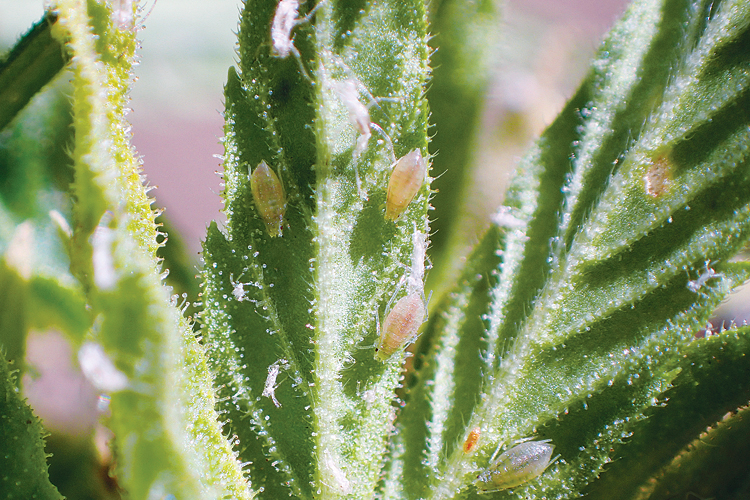
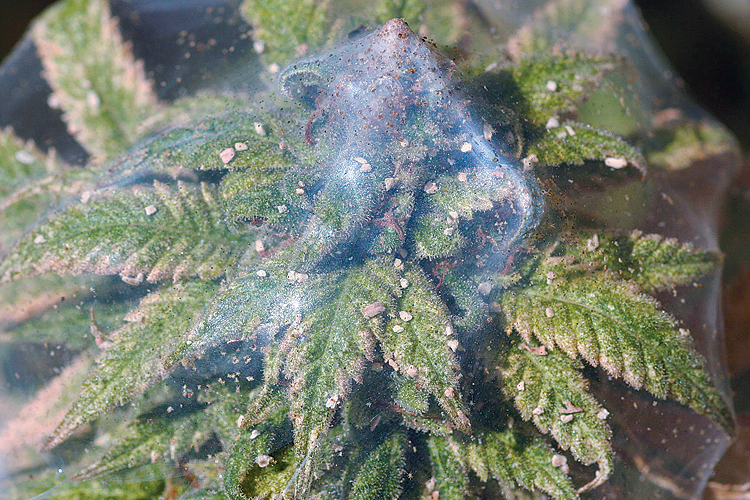
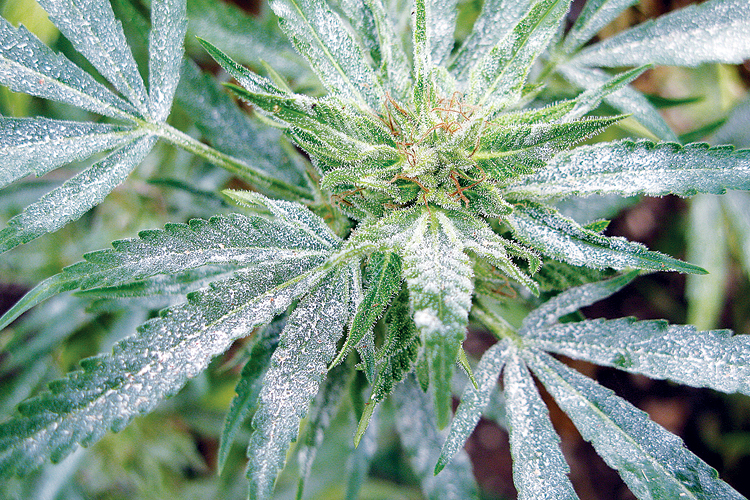



Note: State laws on use of pesticides and biological control organisms vary.
“My grandma used to grow roses, and she had bags of blood meal and bone meal around. I just threw that in the pots,” Funtanellas recalls. He had early successes but also lots of failures. “I haven’t made all the mistakes, but I’ve made a lot of them,” he says. He founded Phantom Farms in 2008 to produce and sell medical marijuana, which has been legal in Oregon since 1998.
By growing outdoors rather than indoors, Phantom Farms benefits from nature’s free sunlight and breezes. But outside, certain conditions can cause populations to explode, explains Conner Luckey, a manager on the farm. For example, insects can thrive in the spring if winter temperatures don’t get cold enough. Fungal diseases such as powdery mildew can also emerge in the spring if it’s long and wet.
Factors on the farm can make plants vulnerable as well. If plants are under stress, such as from lack of a key nutrient, they will emit chemical signals that attract hungry insects from far and wide. And pests can catch a ride to the farm on young plants brought in from elsewhere or on the clothes of workers or farm visitors.
These kinds of pest pressures are common in agriculture and are usually mitigated with well-timed application of insecticides and fungicides. But Phantom Farms relies on prevention instead because the self-taught Funtanellas and Luckey have decided not to use any synthetic pesticides.
For them, the first line of pest defense is growing healthy plants. The farmers plant several types of cover crops to add nitrogen and organic matter to the soil. They make plant food from plants such as comfrey that concentrate micro- and macronutrients from the soil.
Plants like knotweed, along with lavender and other fragrant herbs, help deter pests. Phantom Farms also deploys armies of predatory insects, particularly to control spider and broad mite populations. Luckey’s favorite is the orange-hued predatory mite Phytoseiulus persimilis. “When you release them, they’re starving. They’re just like barbarians,” he jokes.

Using beneficial insects is popular because avoiding the use of pesticides is a goal for most growers. Oregon, like a number of other states that regulate cannabis, will not allow products to be sold that contain pesticide residues. Under federal law, crops, including fruits and vegetables, can contain pesticide residues as long as they are beneath certain thresholds.
“So it’s not only a matter of making sure the product is safe for the customer, but at the same time, it means we are never worried about passing pesticide testing,” Luckey says.
Although Oregon is not one of the larger markets for legal recreational marijuana, its strict and comprehensive testing and regulations are likely to be copied by other states and regions, industry watchers say.
But like all states, Oregon plays a dual role: In addition to writing and enforcing regulations, it works to help cannabis farmers be successful. “We consider it an agriculture crop just like any other crop,” says Grant Jackson, outreach specialist at the Oregon Department of Agriculture.
It wasn’t like any other crop when Jackson started at the department in 2014, just before the statewide referendum that legalized marijuana for recreational use. “It definitely made the job more interesting,” Jackson says. “It’s a new crop for us, and there’s a lot to learn about it. It has been challenging and rewarding helping out a new part of the ag sector.”
Luckey says Phantom appreciates the help. “We can send them tissue samples and they’ll do pest identification for us, which is pretty cool because before that, you couldn’t just call anybody to come see your plants. And it’s free.”
The department maintains a list of pest control products that it considers safe and legal to use on cannabis. It’s an important list because federal pesticide labeling laws do not account for potential use on cannabis. The U.S. Environmental Protection Agency hasn’t approved any products for use on the crop, including those that are certified organic by the National Organic Program.
So Oregon drew up its own criteria, starting with EPA’s rules for pesticide use on food crops. “We are looking for active ingredients that don’t have a residue tolerance in a food crop and are labeled by EPA for broad use,” Jackson explains. “The label should be open ended; for example, it could say ‘can be used on herbs’ or ‘can be used in greenhouses.’ ”

Whether grown in soil or hydroponically, cannabis plants need their vitamins.
Sources: General Hydroponics, Cannabis.info
The rules leave out large categories of commonly used pesticides. Notably, pesticides that are federally approved for use only on specified crops cannot be used on cannabis in Oregon. But rules differ by state. In Colorado, for example, some pesticides labeled for tobacco can be used on cannabis.
Anyone can request that a product go on Oregon’s approved list. Jackson says growers often call asking about a product they have heard is effective and would like to try. Sometimes the request comes from the pesticide company itself.
Many of the products on Oregon’s official Guide List for Pesticides & Cannabis will be familiar to any backyard organic gardener. They include plant-derived insecticides such as pyrethrins and neem oil; the insecticidal bacteria Bacillus thuringiensis; and copper octanoate, a fungicide. Fragrant plant oils such as rosemary, garlic, and peppermint can also be used to control insects.
Of course, not everyone plays by the rules or even understands the rules. “A fair share of cannabis growers and producers just don’t realize that a pesticide label is a legal document,” Jackson says.
Advertisement
A cannabis grower facing a possible crop failure due to a pest problem may turn to effective but illegal treatments. In Oregon, the Department of Agriculture is alerted when products fail third-party residue tests. One common problem is that growers use insecticidal pyrethrins along with the synergistic companion chemical piperonyl butoxide at high rates, causing residues to exceed state action levels.
A wide variety of products that are not approved for use in cannabis have also shown up in tests. They include the fungicide myclobutanil and insecticides such as malathion, imidacloprid, and synthetic forms of pyrethrins called pyrethroids.
Another treatment that is found frequently is the biopesticide spinosad, which is not on the approved list because it has federal food residue limits. “We get a lot of questions about spinosad,” says Rose Kachadoorian, regulatory leader at the Department of Agriculture and Jackson’s colleague.
Kachadoorian points out that the state rules for use of pesticides are quite narrow because there is almost no information about the effectiveness and safety of pesticides on cannabis. That could change if larger pesticide companies decide to enter the cannabis market. California and Canada are likely to encourage such testing, and growers could organize into associations to participate.

However, doing risk assessments on cannabis is complicated, Kachadoorian says. “For a food crop like apples, you just need to look at the fruit or the apple juice. That’s just two products and only oral exposure. With cannabis products, the exposure can be from smoking it, eating it, or putting it on skin; some exposures bypass your body’s system that would normally break a pesticide down in the liver.”
Similarly, cannabis products may contain extracts made with CO2, butane, or water; different extraction methods can result in different types or quantities of residue. Finally, unlike the case of eating apples, consumers’ exposure to cannabis can vary widely depending on whether they partake on the occasional weekend or use it daily.
Since legal growers must be concerned about pesticide residues, they are typically game to try biological products that work well on fruit trees and other specialty crops. Biopesticide producer Marrone Bio Innovations found out through word of mouth that its products have been popular with marijuana growers even before the legalization trend, and now interest has exploded.
“Growers were beating a path to our door with basic questions to our sales team—we couldn’t keep up with the calls,” founder Pam Marrone says. For example, the callers needed help to translate application rates from the label’s indication of pounds per acre to a more useful tablespoons per gallon.
The products the growers were keen to use include Marrone Bio’s Regalia for prevention and control of powdery mildew. Its active ingredient is an extract of Reynoutria sachalinensis, or giant knotweed. For mites, growers can turn to Grandevo, a strain of the Chromobacterium subtsugae bacteria, or Venerate, made from another bacteria called Burkholderia.
Marrone says the company decided to support the use of its products on cannabis after learning about the risky pesticide residues that have been showing up in cannabis samples. The company hired a master cannabis grower for its sales team, obtained state approvals for its products, and made smaller packages. Marrone says Regalia is now undergoing cannabis field trials in Canada.
The company’s fact-finding also convinced Marrone that the business opportunity is growing rapidly. A study the company commissioned from the University of California, Davis, estimates today’s market for cannabis inputs at $91 million annually. With more states and Canada now or soon to be on board, the company expects it to reach $1.4 billion by 2021.
“That growth sparks a lot of interest from investors,” she says. What’s more, organic products are very well positioned in the market. “You don’t need synthetic products to drive high yield, and our products are cost competitive,” Marrone asserts. In addition, “Consumers, by and large, have a pretty strong bias toward the organic model.” Her firm will soon launch a new brand to target the industry: CG, which stands for cannabis garden.
Another company that is betting big on the cannabis market is Scotts Miracle-Gro. Though it is known mainly for its consumer lawn care products, Scotts began acquiring indoor gardening firms in 2015. In addition to lighting and equipment companies, Scotts acquired Botanicare, Vermicrop Organics, and General Hydroponics, three firms that sell specialty plant nutrients and pest control.

The Scotts website doesn’t mention that cannabis is the main market for the three companies, which are now brands in its subsidiary for cannabis growers, Hawthorne Gardening. The press release for its recent $450 million acquisition of Sunlight Supply, a hydroponics equipment maker, says nary a word about it. And like a number of mainstream agrochemical producers, Scotts didn’t respond to a request from C&EN to comment about the use of its products by marijuana growers.
But in an earnings call with analysts earlier this month, CEO James Hagedorn was clear that Hawthorne’s business model is heavily reliant on cannabis growers, particularly in California. And business has been tough there because of a bumpy rollout of the state’s new legalization effort, which is controlled at the county level.
“California continues to struggle with the transition from a large and loosely regulated market for medical marijuana to an even larger but strictly regulated recreational marijuana market,” Hagedorn said. Another problem, he said, is that growers in California and elsewhere had ramped up production in anticipation of widespread state legalization. For now, the supply of marijuana outpaces demand.
Hagedorn predicted that the excess inventory and slow rate of state licensing will cause some smaller-scale growers to go out of business, leaving more professional medium- and large-scale operators. “We’re definitely in a position to thrive in that environment over the long run,” he said.
Oversupply has already caused retail prices to fall by 10–20% in Washington, Oregon, and Colorado, according to Oregon’s Office of Economic Analysis. Early this year, wholesale prices in Oregon dropped to about $2.00 per gram.
At Phantom Farms, Funtanellas says he plans to keep production costs to $1.00 per gram. One way is to move into indoor production, a small but growing slice of the industry. Indoor operations produce more cannabis on a smaller footprint and require smaller amounts of nutrients and water, which are delivered using automated systems.
Indoor growing works anywhere, regardless of sunlight, climate, or season. Growers control the spectrum and intensity of light, room temperature, humidity, air flow, and fertilizer timing.
In addition to cutting costs, controlling environmental conditions can alter the amount and ratio of desirable plant chemicals, including tetrahydrocannabinolic acid (THCA) and cannabidiolic acid (CBDA), which are responsible for the plant’s physiological effects, says Brandy Keen, cofounder of Surna, a developer of indoor cultivation equipment.
“We’re not trying to duplicate nature but to do even better than nature,” Keen says. “We want to push the plants to their maximum capacity for stress before that stress becomes negative.” The plants produce CBDA, THCA, and a range of flavor and fragrance compounds called terpenes in response to stresses such as insects, sunburn, drought, or nutrient deficiencies.
In addition, having control over air circulation and humidity helps prevent mold, while a sealed environment keeps out pests. More recently, the use of light-emitting diode lighting systems has helped cut energy use, Keen adds.
The use of controlled environments will be a boon to the science of cannabis growing, contends Andrew Lange, president of the consulting firm Ascendant Management, which works with investors to set up cultivation systems.
“What we’ve found is that the knowledge that came from decades of observational science is mostly not correct,” Lange says. He gives the example of widely available charts that incorrectly show rusty leaf discoloration due to a lack of the micronutrient boron. “Every day we’re finding new things that are completely wrong,” he says.
Lange sees a huge need for chemists and others with science expertise. As legalization spreads and the social stigma that has followed the industry fades, more medium- and large-scale investors will try their hand at growing cannabis. And as the industry becomes more professional, demand for trained scientists will grow, he predicts.
“If you have a STEM background—if you can follow a real scientific method and have a desire to learn something new—there are a lot of problems to work on in this industry,” Lange says. “You can just pick one; it’s very open right now.”
Delving into the cannabis genome

Until just a few years ago, the cannabis genome was a mystery. In the U.S., a strict drug-control regulatory regime and lack of public research funding made it difficult to peer into the secrets of this ancient crop.
Even today, only a handful of researchers around the world are studying cannabis genetics. At the University of Minnesota, plant scientist George Weiblen has begun to crack the plant’s genetic code after more than a decade of work.
Weiblen had to start with very little background information. Research on plants often begins with the model plant Arabidopsis, a relative of the Brassica crops such as canola, mustard, and broccoli. While tens of thousands of papers have been published on Brassica, Weiblen says, “for the cannabis family, by comparison, we’re talking about only a few dozen papers. We’re way behind in our understanding of the genetics of cannabis.”
But advances in DNA-sequencing technology and bioinformatics are making rapid progress possible. “That wasn’t the case 10 or 20 years ago,” Weiblen says. “We have some catching up to do.”
Missing information included the basic question of what gene or genes account for the production of the important cannabinoids tetrahydrocannabinolic acid (THCA) and cannabidiolic acid (CBDA) and how those genes are inherited. To find out, Weiblen crossed the two main types of cannabis: a hemp variety that produces CBDA but very little THCA and a psychoactive marijuana variety that produces predominantly THCA. THCA is the precursor to the well-known compound tetrahydrocannabinol (THC).
He examined many generations of hybrid plants, which displayed a diversity of cannabinoid production, to work out how the traits are passed down.
Cannabis plants make both THCA and CBDA from a common precursor called cannabigerolic acid (CBGA). Depending on their genome, the plants produce different amounts of two synthase enzymes that convert CBGA to the two derivatives.
To Weiblen’s surprise, the hybrid generations produced more CBDA and less THCA than a simple model of inheritance predicted. The data suggest that DNA for the two synthases are not two alleles of a single gene but rather are separate but linked genes that travel together during reproduction.
If cannabis plants are bred randomly, their offspring produce mainly CBDA. Weiblen says this is because CBDA synthase outcompetes THCA synthase for the precursor CBGA molecule. The fact that the dried flowers of some modern strains of marijuana can contain up to 30% THC shows the power of selective breeding. Over thousands of years, marijuana growers selected mutated plants with a nonfunctioning gene for CBDA synthase.
Of course, those ancient plant scientists didn’t know the genetic basis of the plant’s mind-altering qualities. But with a map of the genes on cannabis’s 10 pairs of chromosomes, modern breeders could sort plant populations to find those with genetic markers for desirable traits.
Being able to classify strains by their genetic traits could help consumers find cannabis products with effects they are looking for, says C. J. Schwartz, CEO of Colorado start-up Sunrise Genetics.
For now, cannabis consumers, including those using it for medical purposes, don’t have a scientifically valid classification system to help them find the right strain for their needs. A customer looking for pain relief may try a named variety such as White Widow, reputed to have analgesic effects, but there’s no standard that all cannabis labeled White Widow has to meet.
“Years ago, some of my plant biologist colleagues and I talked about the naming system of cannabis and how it’s ridiculous,” Schwartz says. “We decided that to have some legitimacy and transparency, let’s use DNA evidence to say what people are getting.”
The benefit of using DNA analysis goes beyond classifications based on CBDA and THCA synthases. Schwartz says the genome can help target other cannabinoids and terpenes, though much less is currently known about their biological effects.
In addition, growers can use the map to identify plants by agronomic traits such as flowering time, nitrogen usage, and drought tolerance, Schwartz says. In the long run, Sunrise hopes that with a well-characterized genome map, plant breeders can create stable, branded products that best fit their customers’ needs.

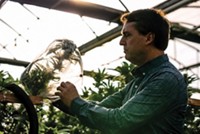
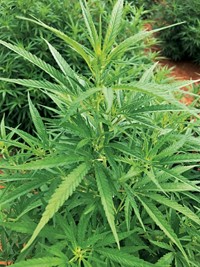
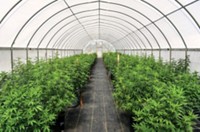

Join the conversation
Contact the reporter
Submit a Letter to the Editor for publication
Engage with us on Twitter